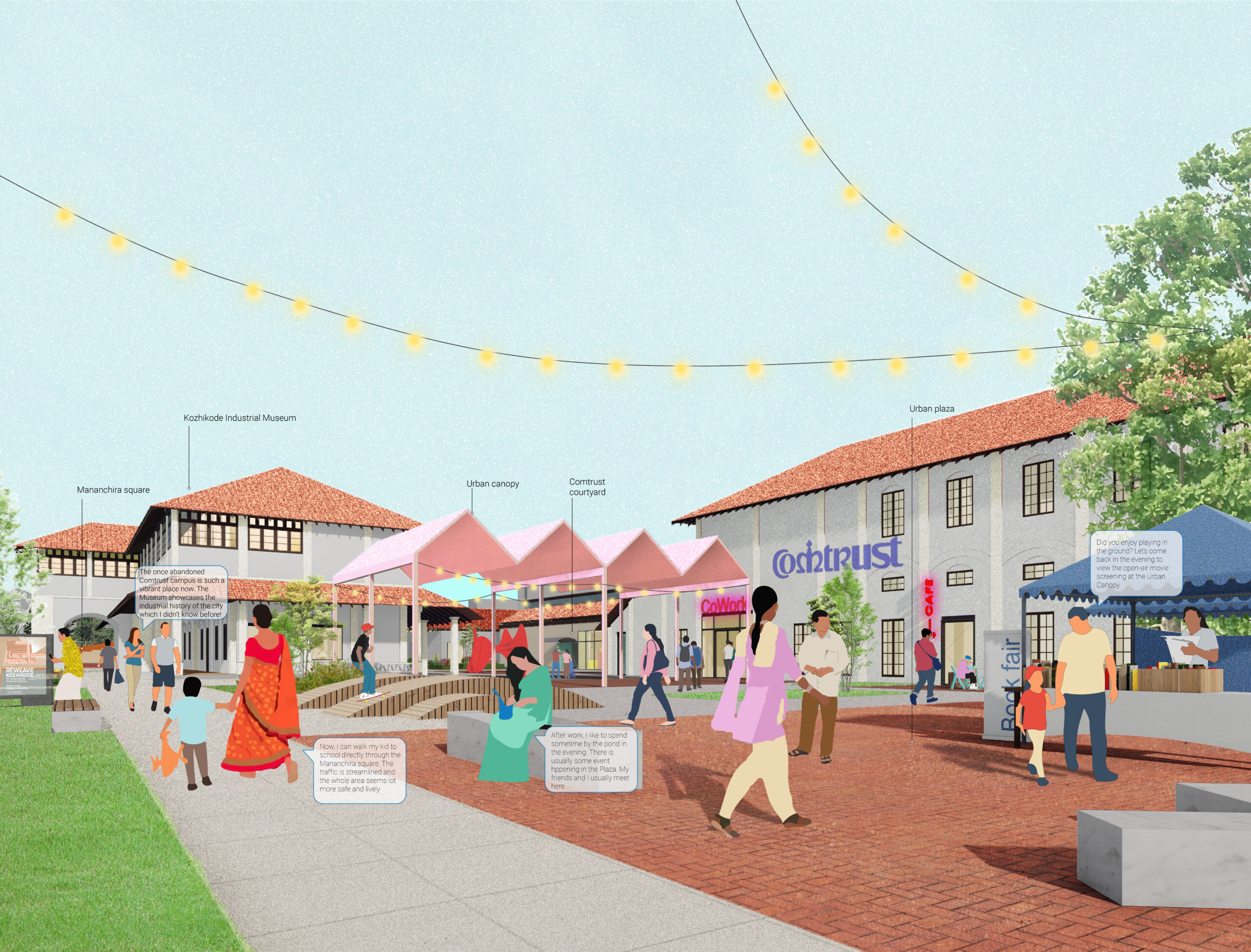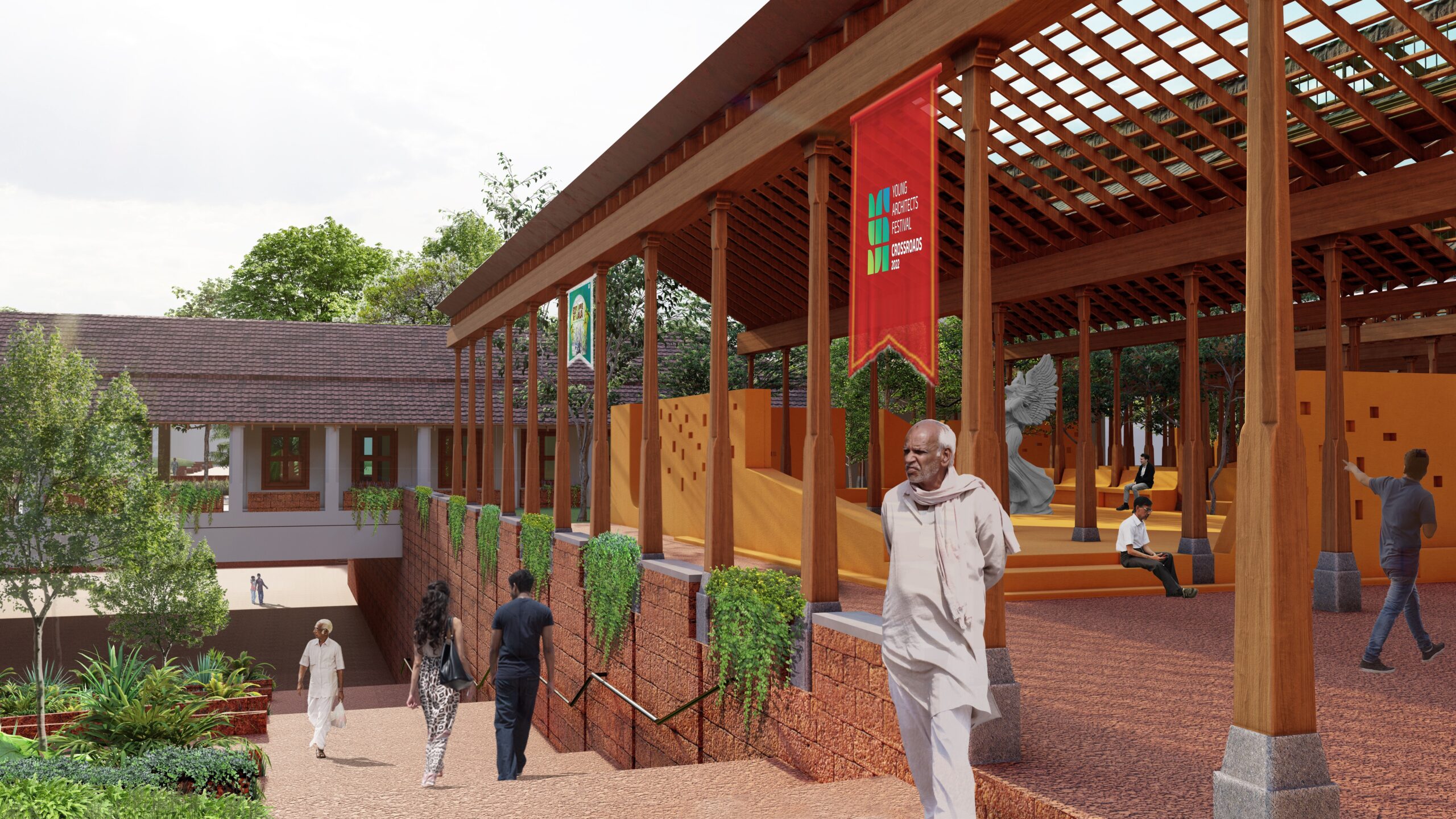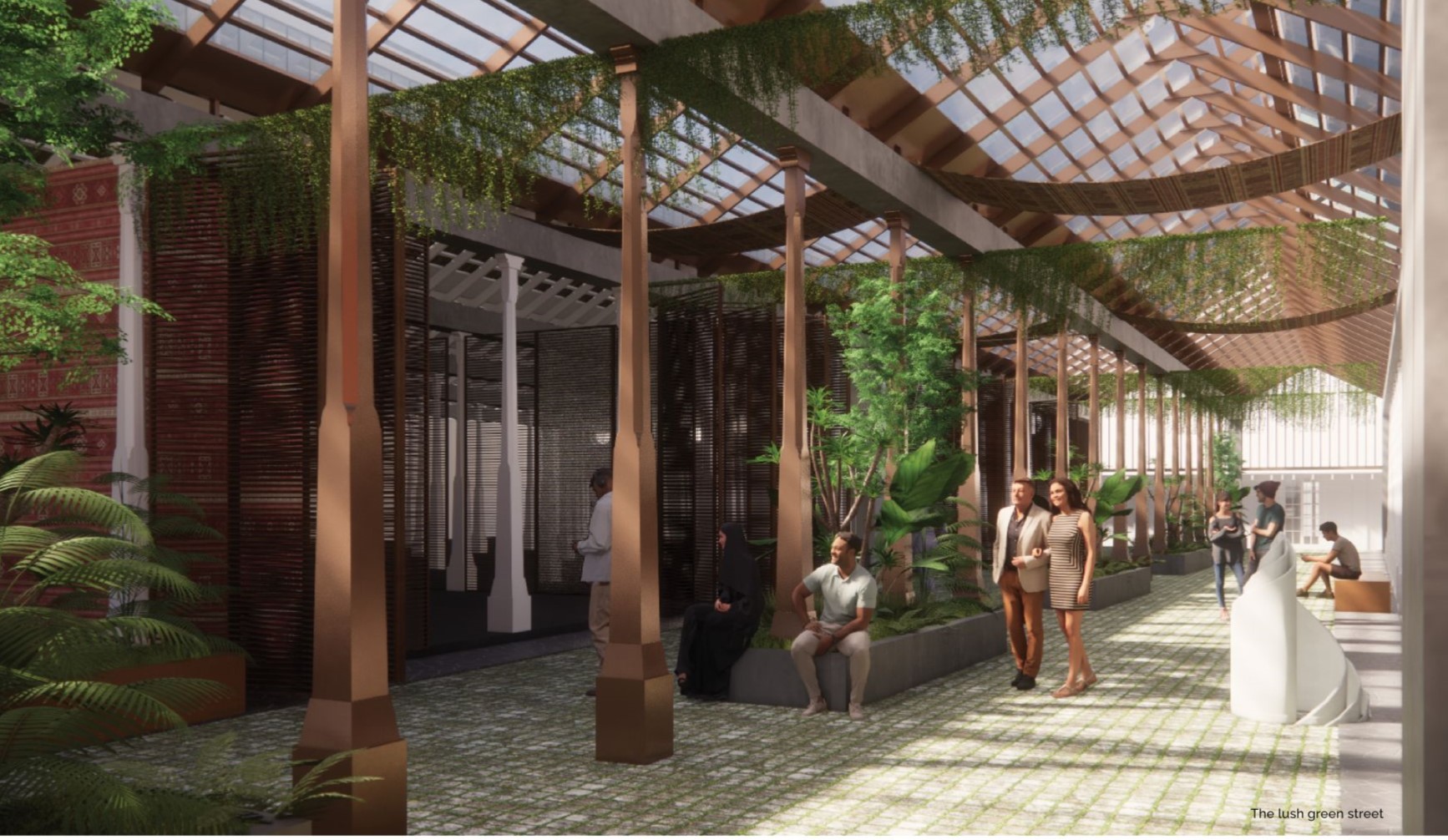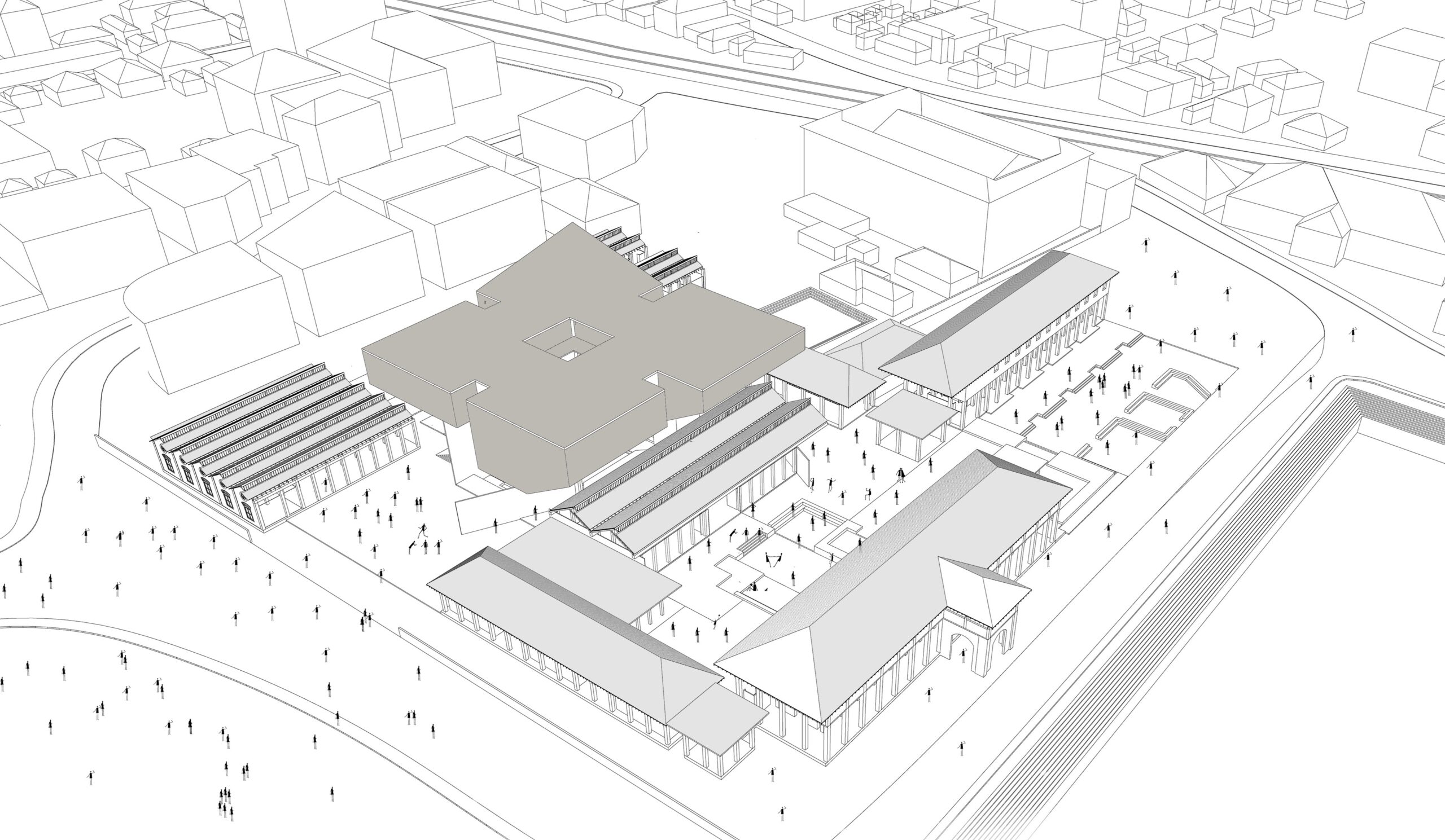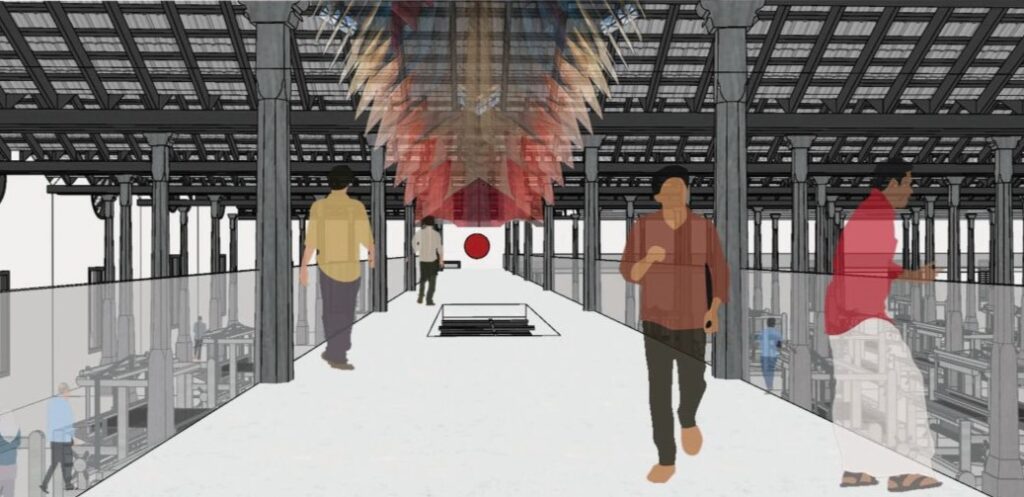
Ezha‘s Reweaving The Missing Link was chosen as the finalist entry in the Reweave Kozhikode Competition, held at YAF, by the IIA Calicut Centre.
The Comtrust Precinct lies in a strategic location within Kozhikode city sandwiched between vibrant streets and active urban nodes. The significance of this precinct within the urban context is largely attributed to the historic buildings and historic urban open spaces.
On the urban scale, however, a social disconnect between the eastern and western edges of the precinct is identified due to re-routed one-way streets, heavy traffic, and lack of exclusive pedestrianized pathways. The historic buildings identified in the precinct remain solitary landmarks without integration into the larger urban fabric. The urban commons including Mananchira Park, Maidan, Ansari Park and Mananchira Pond are not linked to the minor open spaces of the precinct. Moreover, the Comtrust factory building which has remained a cultural identity of Mananchira is irreversibly losing its heritage values due to abandonment, obsolete function, economic degradation of calico production and lack of maintenance.
EZHA is an urban and heritage-centric approach for reviving the Comtrust Precinct as an intersection of three main dimensions: Nature, Heritage and Urbanism. Nature induces activity generators within green and blue open spaces to create functional and vibrant urban nodes. Heritage invigorates the deteriorated and abandoned factory precinct with suitable and context-based interventions. Urbanism integrates the disconnected urban commons of the precinct using the Comtrust site as a connector.
The initial concept for the framework was based on the thought process, “Whom are we reweaving for…?” Cultural identity and collective memory are invoked by the fourth dimension that links the other three: the Community.
The urban level proposals commence with the mapping of the existing heritage resources in the precinct and proposing a Heritage Trail linking the historic buildings and historic open spaces. The road between the north end of the site and the pond is proposed to be pedestrianized with an interactive deck along the Mananchira pond to create a fascinating viewing experience. A people’s pathway providing a safe and efficient way for pedestrians to safely cross over from the eastern to the western edge of the precinct through the Comtrust factory, also allows the people to appreciate and value the iconic industrial heritage of the city. Grafitti walls and Children’s play areas are envisioned in minor green pockets within the Comtrust site connecting the larger green and blue open spaces through green corridors.
A heritage value assessment of the precinct using international industrial heritage charters revealed the historic, social, economic, architectural and technological value of the Comtrust Factory site. The historical value is attributed to the Comtrust factory which is a heritage structure of more than 150 years old and associated with the Basel Evangelical Mission. The collective memory as part of the record of the livelihood of men and women who worked here invokes a social value. The high land value of the factory site has the potential for income generation by adaptive reuse and is of economic value. The architecture, design and planning of the factory is a blend of the Kerala style of architecture with clay tile sloping roofs, long verandahs and courtyards, timber stairs, and the Victorian style with the large scale of the building, large columned verandas, ribbon type windows, grand porch in the entrance and typical arch shape provides an architectural value. Evidence of industrial activities and evolution of the textile industry from handloom to the introduction of power looms, unique German-based technology and machinery issue a technological value and global acclaim of the calico product for its quality and design, export of textile in mass quantities to Europe and supply of fabric to fashion designer studios, across the world attributes it an especial or rarity value.
The framework envisions the Comtrust Factory site as a people’s edifice linking the past, present and future, with objectives to connect history and the people, allow for public activities to experience the grandeur of the spaces and thereby create awareness about the significance of the building, restore the heritage values inherent in the building and recreate the past functions to cater to the present needs.
The conservation strategies incorporated to achieve these objectives are:
• Restoring the original plan form and design of the structure.
• Re-directing the existing circulation for a better user experience of the heritage building
• Providing spaces for public use such as Gallery, exhibition, lodging rooms and café.
• Providing amenities supporting the official activities.
The initial conservation phase involves the condition assessment of the existing structures, identifying structures to be retained, recording critical areas for immediate strengthening and proposing measures for restoration.
The design phase involves the adaptive reuse of the factory building and site by reviving the past use and inducing new functions as activity generators. The original structure of the colonial era is restored by the removal of incompatible additions and alterations and by improving the visual porosity of the structure to the North through solid-void interfaces in the façade. The main entry from the North opens to a green court leading to the main exhibition space and guest house. The office spaces are incorporated to the east and connect to the record other service areas to the west via semi-void weaving process areas and green courts. The Canteen, Kitchen, Dye House and office spaces are retained continuing their original function.
Varying heights of the weaving areas and the use of double-height spaces, connecting viewer bridges and transparent material palette gives rise to the perception of varying volumes with the chimney as the character-defining element. The pedestrian entry from the east moves between the weaving process and training areas incorporating skill development and fashion designer studios and connects to the open court for events on the western edge. An additional facility to improve stakeholder partnership is the Kudumbasree-run Boiler café and canteen, housed within the boiler building with semi-open courts as galleries for outdoor exhibitions and events.
Thus, the Comtrust precinct is envisioned as an intricate and complex pattern of the urban fabric interwoven through the holistic and heritage-centric approach using natural, urban, heritage and community threads of EZHA!
Presentation Sheets




